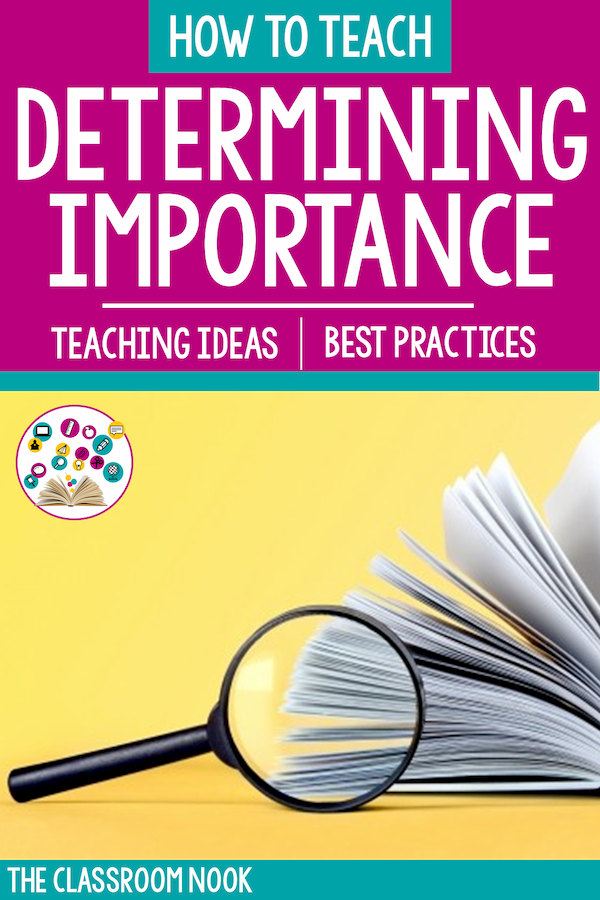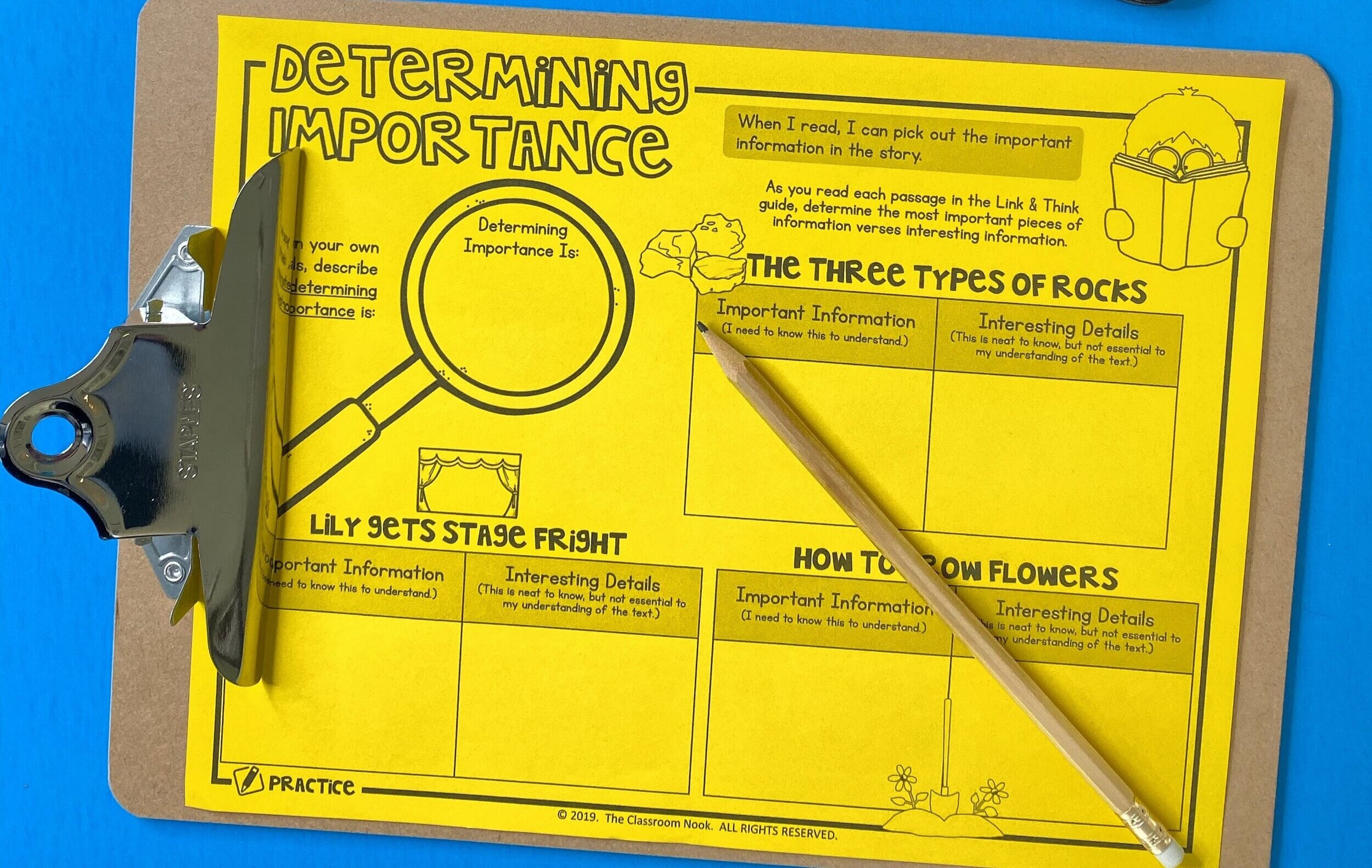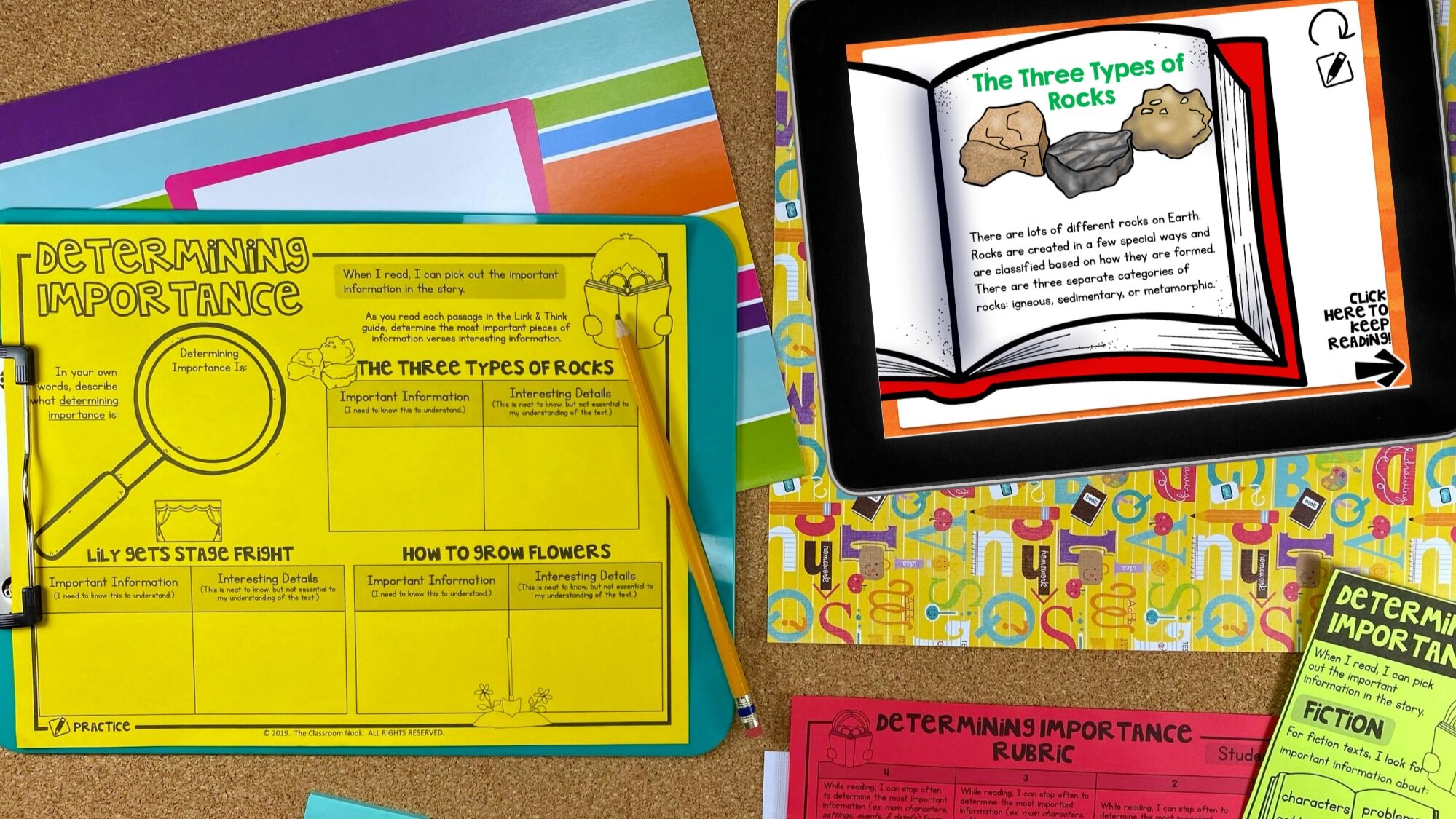How to Use Reading/writing Journals in the Classroom
Reading Comprehension Strategy Series: How To Teach Determining Importance in the Upper Uncomplicated Classroom

Equally with many things that students learn in school, there are several fundamental skills that are needed in order to develop newer, more complex skills. Determining importance is 1 of those fundamental skills that will lead to greater success in mastering other concepts and skills.
For example, in guild to summarize a text, a student needs to exist able to determine the of import data first before crafting a summary. In order to infer something about a text, students first demand to have the ability to choice out important data that informs their inferences.
Young readers tend to call back that everything that they read is essential. However, students can't read effectively if they effort balance every detail as equally important in their minds.
Pssst…Want a super engaging and interactive way to have students practise visualizing?
LINKtivity® Interactive Guides are EXACTLY what you need to make learning fun & accessible for all!
Get access to the Visualizing LINKtivity® (+60 others and counting!) inside of LINKtivity® Learning - an all-access laissez passer to our entire vault of LINKtivities!
Below are the different categories within this post to assist y'all jump to exactly what you lot need! Click on each category title to navigate in that location straight:
<< Back to categories
what y'all demand to know earlier teaching the Determining Importance reading strategy:
In short, determining importance means that the reader focuses on what's most important in the text so that he/she tin can develop deeper meaning and overall understanding of the text. Practiced readers are able to decide, from everything on the page, what is about important to retrieve.
Boosted details provided by the writer make the text more interesting, but beingness able to excerpt the almost of import details volition lead to true comprehension and retention of new data.
Determining importance also means that readers take to monitor their thinking as they read in order to notice when something important has been shared within a text. In a sense, readers "file" these important details away in their mind and pull them out later in order to see how they all fit together as main ideas and themes. When readers can sort out the big ideas from the text, they are able to filter and organize all other information gained from the text around those ideas.
To decide importance in fictional text, students need to hone in on important things a character says and does, and how those words and actions event the events of the story. They too need to notice how settings can play an important role in the story. When reading fiction, students should determine which events and characters make the biggest impact on the story as a whole. Students should pay attention to a grapheme'due south development overtime and how that development impacts the consequence of the story. They likewise pay attending to graphic symbol relationships too as problems and solutions. Finally, students use all of these importance details from the text to determine major themes from the story
In nonfiction texts, students determine the main facts, details, and vocabulary virtually a topic by noticing text features such as headings illustrations, graphs, bold words, photographs, and others. These text features are often included to draw the reader'southward attending to the most of import information that the writer wants to share. As texts become more complex and dense with information, sorting through of import and nonimportant facts becomes even more than essential.
In both fiction and nonfiction, pedagogy students to determine importance allows them to movement through a text coherently, leaving behind details that clog our retention, keeping only the critical pieces of data needed for concise comprehension.
<< Back to categories
Innovate THE DETERMINING IMPORTANCE READING STRATEGY TO STUDENTS

As with any new concept, you'll want to introduce this reading strategy with physical examples that are simple for students to sympathize. To brainstorm, play a fun game of "Pick 3.". In this game, present students with several scenarios where they are required to pick the iii most important things related to that topic. Have a baseball for example (see anchor chart on the left). Provide students with several items that are related to going to a baseball and have them place and justify the 3 most of import items.
Ask students to choose the three most essentials items needed to play in a baseball game game. Require students to justify their reply. Students near likely will decide that the mitt, bat, and baseball are the 3 near essential items because y'all need all 3 of those to play. The lid and shirt are nice to help yous place which team someone is playing on, merely aren't essential to actually playing the game. Likewise, popcorn might exist a fun snack to accept while watching a baseball game, simply is certainly not essential.
To extend this activity even further, y'all may even want to interruption students up into groups, giving each group a different scenario to talk though.
To set up for the action, write the scenario on the front of an envelop (ex: going bowling) and write several particular on index cards to exist placed in the envelop. Provide each pocket-sized grouping with an envelop and accept groups determine on the iii most of import items every bit they relate to the scenario. When groups have had a chance to hash out, take each grouping share out their thinking. Possible scenarios might include:
-
going bowling: bowling ball, pizza, bowling shoes, bowling pins, soda, music
-
making an ice cream sundae: ice cream, basin, sprinkles, ice cream scoop, hot fudge, cherry
-
going camping: tent, sleeping bag, frisbee, firewood, southward'mores, matches
-
things to bring to school: bookbag, homework, lunch, pencils, paper, iPad
Depending on the age of your students, your detail choices may be more or less obvious every bit to which 3 items makes the most sense. For older students, choose items for each scenario that will spark a greater debate, while with younger student, yous might want to arrive more obvious as to which 3 items are the well-nigh important.
<< Back to categories
MODELING HOW TO DETERMINE IMPORTANCE WHILE READING
To help students understand the concept of determining importance, information technology might be helpful to employ a visual. For example, describe determining importance like draining a pot of humid water and spaghetti into a strainer. When y'all pour the hot h2o and spaghetti into the strainer, the water slips through the holes, leaving simply the noodles backside. Y'all don't need the water anymore, merely the noodles. In the same way, when we read, our brain is similar that strainer. We go on only the important things, and let everything else strain out. Choose a read aloud text to show this strategy in activity. Alee of time, create an ballast chart with 2 columns: Of import Information and Interesting Details.

Gear up several sentence strips that you can tape up on your ballast nautical chart as you read. On each sentence strip, write an importance piece of data OR an interesting detail from the read-aloud text that you lot plan to share. You will need several of each.
When information technology'southward time to share your read-aloud, explain that as you read, you volition end often to record the information that is important to think on 1 side, and record interesting details on the other side. As you come across the information that you wrote on each sentence strip, model how you decide if that slice of data is important or interesting. Be sure to justify your thinking.
Over the course of several days every bit you initially introduce this strategy with several read-aloud texts, gradually release more than responsibility to your students. Allow them to begin adding to your anchor nautical chart with their own thoughts about what they consider to be important/interesting. You might want to provide your students with several Mail-it notes, stopping oft for them to record a piece of data to be put up on either side of the nautical chart Require students to justify their responses.
DETERMINING IMPORTANCE IN FICTIONAL TEXTS
Of course, the process of determining importance will vary depending on whether you're reading fiction or nonfiction. With fiction, it's of import that students understand the overall structure of well-nigh fictional texts. This text structure will oft help them to make up one's mind what's important. Hither's what a typical fictional text looks like as a "story mountain:"

Help students to place where on the story mount their "important information" falls into. If it doesn't fall easily onto the story mountain, it is probable not considered important information, only rather an interesting detail.
DETERMINING IMPORTANCE IN NONFICTION TEXTS
In nonfiction, nonetheless, the text structures can vary greatly. Nonfiction text structures include: descriptive, sequential, compare/dissimilarity, cause/effect, and problem/solution. ). You might choose to use a graphic organizer unique to each structure to help students go along rails of important data. (See following page for graphic organizer examples)
These graphic organizers will assist students keep only the virtually of import information top of heed.
Of course, determining importance is more than only remembering the important details and then that students can summarize the text. Although this is where most teachers offset their instruction on the determining importance reading strategy, it is not where it should stop. One time students understand the concept of determining of import details, we want to teach students to determine other of import pieces of information such as:
-
determine when and why a character begins to change
-
make up one's mind the importance of something a graphic symbol says or does (and why it is important)
-
determine the importance of a story's setting
-
determine the significance of an event in a story and how information technology will bear on the residuum of the story
-
decide the importance of a nonfiction text feature that an author includes (what is it trying to teach the reader?)
-
determine the most important theme in a story
-
decide the most important lesson learned in a story
-
determine important vocabulary introduced in a text
Each of the bullets to a higher place could potentially be individual mini-lessons or learning targets touched on in small guided reading groups.
<< Dorsum to categories
Cull TEXTS THAT Assist IN DETERMINING IMPORTANCE:
Of course we desire students to be able to make up one's mind importance regardless or what book they are reading. However, as students have their start experiences working this this strategy, choosing books that provide obvious opportunities for students to pull out important information. This will help gear up students upwardly for success and will railroad train their brains to distinguish between important and interesting.
Hither are some of my favorites: (affiliate links)
-
The Important Book by: Margaret Wise Brown (this is a not bad book to introduce the reading strategy)
-
Honey Will Come across You Through by Angela Farris Watkins
-
The Stray Dog past Marc Simont
-
Grandpa's Journey past Allen Say
<< Back to categories
PRACTICING DETERMINING IMPORTANCE
CREATE Elementary VISUALS TO REMIND STUDENTS TO DETERMINE IMPORTANCE
When showtime using a new reading strategy, students demand constant reminders. Visuals such as bookmark to use while reading, or a classroom poster that is displayed on a reading strategy bulletin lath work wonderfully to nudge students to focus on the important details while reading.
Continue to create anchor charts displaying of import vs. interesting details that you lot detect during read-alouds.

8 Gratis Reading Strategy Bookmarks
Grab these FREE student bookmarks to help your students use reading comprehension strategies while reading.
At that place are a total of viii bookmarks that explain reading strategy in child-friendly linguistic communication and is the perfect reference for students to use during contained or small-scale-group reading time.
USE LINKtivity DIGITAL LEARNING GUIDES
New to LINKtivities? >> CLICK HERE
OF COURSE I have a LINKtivity for y'all to help teach determining importance. Of class! What else? Sentinel the video below for a sneak peek:
Here's how it works:
In the Determining Importance LINKtivity, students outset spotter a curt blithe video clip that quickly catches their attention with fun doodles and images. The clip introduces what the strategy is and how readers employ it.
From there they read alongside their "virtual reading buddy" to see the strategy practical to a text. While clicking through the digital book, each fourth dimension the student comes across a thought bubble, they click on information technology and are brought to a new slide in the LINKtivity guide to see what their reading buddy is thinking!
So, to take their learning to the next level, students read three boosted high-interest reading passages to do the strategy on their own. In a like mode as they did with their reading buddy, students click through the digital storybook and terminate to decide importance along the way. The students can record their thinking on a recording sheet that goes along with the LINKtivity.
Have STUDENTS Go along TRACK OF IMPORTANT INFORMATION VS. INTERESTING DETAILS WHILE READING

Having students write down the pieces of data that they deem of import is cardinal when information technology comes to informing y'all of their agreement of the strategy. From their written details you lot can encounter if they tin sort out importance information from interesting details.
Writing downwards their thoughts too keeps them accountable for their learning and gives you an informal assessment.
<< Dorsum to categories
ASSESSING YOUR STUDENTS ON DETERMINING IMPORTANCE
Assessment, whether it be formal or breezy, drives instruction. For more informal assessments, accept notes about a students use of the determining importance reading strategy during reading conferences or in small groups. Considering the following when observing the students' utilise of the strategy:
-
Are students able to identify when something significant has happened in the story that they are reading?
-
Tin can students summarize the text using but important details?
-
Can students identify important characters and settings?
-
Do students pay attention to nonfiction text features and draw out important information establish in those features?
-
Tin can students make up one's mind new and important vocabulary in the text?
-
Tin students justify why something is important?
-
Can students determine important details from a text to identify themes and lessons learned from a story?
Finally, having a rubric written in kid-friendly language is specially helpful when providing feedback to a student on their ability to determine importance. The rubric can provide clear guidelines on how to decide importance while reading.
<< Back to categories
Resources for Determining Importance

Want to get your hands on the Determining Importance LINKtivity®?
Join the LINKtivity® Learning Membership and start using this gear up-to-become resource for determining importance that includes:
-
a instructor guide
-
a student LINKtivity
-
a student recording canvass
-
a educatee-friendly rubric
Get admission to the Determining Importance LINKtivity® PLUS all the other reading comprehension strategies inside of LINKtivity® Learning - an ALL-ACCESS pass to every single LINKtivity® created (INCLUDING all 7 reading strategy LINKtivities!)
Check out the other posts in this series
Source: https://www.classroomnook.com/blog/determining-importance
0 Response to "How to Use Reading/writing Journals in the Classroom"
Post a Comment